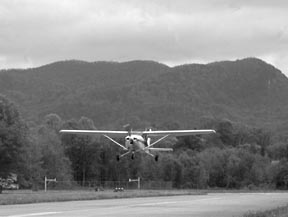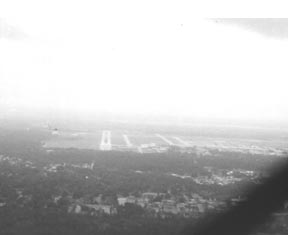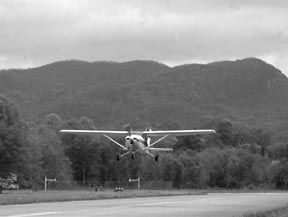
by Ron Levy
Flying under IFR is usually equated with flying in the system. We often feel as though ATC is, like Ed Reimers in the old insurance ads, holding us in their hands, keeping us safe from other traffic and the ground as long as we do what they say.
Unfortunately, that is true only as long as the flight is actually in the system, and IFR operations often extend out past the limits of that system. When you are operating at or outside those limits, the level of protection provided is considerably lower, and sometimes nonexistent. In particular, operating under IFR in and out of nontowered airports puts you both on and over the edge of the systems limits.
There are both procedural and safety issues that arise when operating IFR outside the boundaries of ATCs control and while making the transitions into and out of that controlled airspace. For the most part, well focus on the safety issues – things you as a pilot can to get in and out of nontowered airports under IFR in both IMC and VMC without hitting another plane or the ground.
There are a number of considerations. One is the process of getting an appropriate clearance into/out of controlled airspace – a point where both safety and procedure come into play. Another is the problem of safely navigating your way through the space from the runway to the base of controlled airspace, or vice versa, in IMC. This includes the matter of getting the weather for that airport and selecting an appropriate approach or runway. A third is the issue of avoiding conflicts with VFR traffic at or around that airport when its marginal VMC.
Airspace Considerations
Generally speaking, nontowered airports are located in Class G uncontrolled airspace underlying Class E controlled airspace. ATCs responsibility for the separation of IFR traffic from other known traffic ends at the E/G juncture. Outside controlled airspace, the PIC is responsible for his own separation from other aircraft.
In theory, a pilot can operate in sub-VMC conditions under IFR without an ATC clearance in Class G airspace. However, to enter or operate in controlled airspace under IFR, an ATC clearance is required.
Now, there are limits to this concept. The FAA has taken the position that operations in IMC in the Class G airspace between the surface of a nontowered airport and the overlying controlled airspace without a clearance into or out of that overlying controlled airspace constitutes careless/reckless operation as defined by FAR 91.13, and the NTSB has backed them up.
The FAAs argument is that anyone doing so cannot be reasonably sure that he wont collide with another aircraft arriving or departing at that airport with a clearance into or out of controlled airspace. Therefore, a fundamental legal as well as safety premise is that you should not attempt a departure at a nontowered airport in IMC without an ATC clearance out of/into the overlying controlled airspace and a release in your pocket.
Take careful note of the need for both a clearance and a release. The release is in many respects more important than the clearance. Think of this as being analogous to the need for both an IFR clearance and a takeoff clearance at a towered airport. The importance of this issue is best seen in the Tenerife accident, in which an airliner given a route clearance while sitting on the runway in heavy fog confused it with a takeoff clearance, and ran into another airliner that had not yet cleared the runway.
The difference is that a tower takeoff clearance guarantees you separation from other aircraft on the runway as well as IFR separation, while an ATC IFR release only guarantees you separation from other IFR traffic under ATC control.
Particularly where a Remote Communications Outlet (RCO) is available, you may receive your route clearance (ATC clears N12345 to the Squirrel Pit Airport via…etc.) and be told, Hold for release. The importance of this is twofold. First, it allows you to receive and confirm your route clearance in an unhurried manner. Second it allows an expedited departure release process once the airplane whose presence prevents your immediate departure clears the area or cancels IFR.
Another issue relates to ATCs ability to see you on radar. When ATCs radar coverage is limited, they must separate IFR aircraft procedurally rather than by radar. This means the use of time and position reports.
In general, if ATC cannot see the whole approach on radar, they will operate on a one in, one out basis. In this situation, only one aircraft is permitted to be flying the approach or departing the airport at once.
If you show up at the IAF after another plane on the ground has been released but is not yet in radar contact, you will have to hold until that other plane can be confirmed clear of the approach. Likewise, once a plane has been cleared for the approach, no departures will be released until the approaching plane cancels IFR either in the air or on the ground. So when considering IFR operations at nontowered airports in IMC, be prepared for some delays.
Keep in mind that the release will be based on other traffic, and will always include a void time after which your release is cancelled, and instructions on what to do if you are not in the air by release time. ATC will sanitize the airspace around the departure airport from your release time until they hear from you.
If they dont hear from you, and dont pick you up on radar, they will assume that you have either lost your radios or crashed. They will hold the airspace closed to other traffic while they contact the departure airport or send the local sheriff out to try to find out what happened to you. Regardless, after 30 minutes, they will reopen the airspace on the assumption that you are either airborne, NORDO, and well clear of the area, or, let us say, no longer a factor in terms of separation from airborne aircraft.
Strict adherence to the release limit times is absolutely essential to prevent traffic conflicts, and prompt notification to ATC if you dont launch is an important courtesy, not only to other pilots, but also to ATC and the local authorities.
IFR in the Air
The most dangerous part of operating IFR out of nontowered airports involves the practice of departing under VFR and picking up your clearance once airborne. On clear days, with lots of room between clouds and ground and good visibility, this is not a particularly difficult problem. However, pilots can get in deep trouble if they allow their impatience to get the better of them when the weather is marginal, skip the pre-takeoff telephone clearance, and take off VFR with the intention of getting a clearance once airborne.
On December 11, 1991, the crew of a Beechjet 400 filed an IFR flight plan for a 15-minute flight from Rome, Ga., to Huntsville, Ala., in marginal VFR conditions. The ceiling was around 1,500 to 2,000 feet, with four miles visibility in scattered light rain showers.
The jet took off VFR at 9:37 am with the copilot flying. Once airborne, the captain contacted Atlanta Center to obtain an IFR clearance. Center advised that other traffic was in the area and instructed the flight to remain VFR while an IFR clearance was being arranged. At that time, the flight reported at 1,300 feet in VFR conditions.
The CVR tape showed that the crew became concerned about higher terrain and low ceilings while waiting for their clearance. At about 9:40, the captain directed the copilot to fly back to the right. Approximately 1 minute later, the CVR stopped recording and radio contact was lost. Later, the aircraft was found where it had collided with the top of Mount Lavendar at approximately 1,580 feet msl.
The keys to avoiding this are to be sure before you launch VFR intending to pick up your IFR once airborne that you have a plan in case you dont get immediate radar contact, vectors and a clearance as filed. If the local conditions are not good VFR, your options get very limited, very quickly.
Another problem occurs even if you get your clearance immediately, but the clearance is to an intersection you never heard of via a route you neither filed nor planned, combined with a vector directly into a maturing thunderstorm or a climb to an altitude at which moderate rime/mixed ice is forecast or direct to a VOR station you cant find on the L-chart. This is the sort of situation that a two-pilot crew can handle a lot better than a solo aviator, but even then can tax everyones ability.
Generally speaking, unless the weather allows a VFR climb to the MEA or MVA in your area, or youll have no trouble holding low or returning to your departure airport VFR, you should get your clearance and release before takeoff, especially if youre operating single-pilot.
You also have to worry about how to get from the nontowered airport to the beginning of your controlled airspace clearance. Many airports have published departure procedures to help. These include not only the graphic DPs (what used to be called SIDs) but also the textual procedures in the front of the FAA approach chart books or on Jepp charts on the back of the first approach chart for the airport.
These help make the transition much easier, but what do you do if there isnt one?
The FARs and the AIM have little to say on this subject. You are pretty much on your own to get yourself from the runway up to the controlled airspace entry point without hitting anything. In order to do this, youd better have a visual navigation map (such as a sectional) with you.
Only with an accurate depiction of the terrain around you can you determine a reasonably safe way to get there from here. Its no secret that a lot of pilots who fly IFR carry only the IFR en route charts and approach plates. When launching marginal visibility, you simply cannot see the rising terrain before you hit it.
These days, when everybody and his brother has a moving map GPS either in the panel or in his hand, its very tempting to use that system to pick your way up to a safe altitude and position. Even IFR-certified GPS units are not approved for this.
The GPS can be an aid to safely getting out of an airport without a DP, but they cant do it alone. The sectional chart is essential to having sufficient, reliable data for planning your departure where no published DP exists.
Weather Wisdom
Another related issue is weather. A lot of folks take a fast look at the reported weather at their departure airfield and assume that what they see is what theyre going to get between takeoff and IFR pickup. Not necessarily.
A ceiling is only the distance between the cloud deck and some specific point on the ground. Cloud bases are usually fairly level with respect to mean sea level, not a height above local terrain. Move away from that point into higher terrain and the deck gets closer to the ground.
A 2,500-foot ceiling at an airport near rising terrain may rapidly become a 1,000-foot ceiling or even hills obscured by cloud within a few miles. For a graphic example of how shocking it can be, check out the terrain around some place like Lebanon, N.H.; Staunton, Va.; or Reno, Nev. This means that even when the ceiling is good VFR, you have to be thinking about what kind of terrain is nearby and whether you stand a chance of the ground rising up to meet clouds in the direction youre headed.
At the Other End
Getting from up here to down there also has its own dynamics. There are several issues to consider, primarily the means of navigation and the weather to expect. Part of this comes back to the preflight planning process.
Many nontowered airports have a standard instrument approach, but most do not. This does not mean you cannot file IFR to such an airport, but there are some restrictions.
First, any time you file IFR to an airport without a published approach, you must file an alternate, no matter how good the weather is forecast to be at the planned destination. Second, you can use an airport without an instrument approach as an alternate, but the weather requirements for that go way up over the standard 600-2 (precision)/800-2 (nonprecision) minimums. The forecast ceiling and visibility for this non-SIAP alternate must allow descent from the MEA, approach, and landing under VFR.
As weather is a big issue, youll need some for your destination. Unfortunately, most nontowered airports do not have weather reporting of any kinds, much less terminal forecasts. Fortunately, there is an acceptable source for forecasts to make these decisions, and that is the area forecast. There are a couple of points to watch out for in this respect.
Unlike METARs and TAFs, unless specifically noted, cloud bases are given in mean sea level rather than above ground level. This may not make much difference on the Eastern Shore of Maryland, but in Denver a cloud base at 6,000 msl is a lot different than one at 6,000 agl when considering whether you can climb or descend in VMC.


Second, there is no area equivalent of a METAR. If the airport doesnt report weather, you have no way of knowing what the weather really is when you get there.
Another problem is that not all automated weather systems report weather into the METAR network. Unfortunately, the only way to tell whether an airport reports into the system is to check the METARs. If its there, it reports, and if its not, it doesnt. The A/FD does not distinguish.
At those airports, the only way youll be able to determine what the weather really is before flight is to call the airport or the phone number for the system itself; these are published in the A/FD. This will also complicate things a bit on arrival as the controller will not be able to give you the current altimeter setting, which is often essential for using the lowest minimums for the field. To get that, you will have to listen to the automated system on the radio at some point prior to reaching MDA.
Arriving in the area, you may either be given an approach to fly, or allowed to pick your own. Keep in mind that the controller does not know what the winds/weather are at nontowered airports if the automated weather system does not tie to the METAR system.
This can create a situation in which the controller wants you to fly one approach for traffic sequencing purposes, but for wind or ceiling/visibility reasons you want to fly another. As PIC, you have to make sure you are not pushed into something with which you are not comfortable.
On the other hand, if you demand an approach that doesnt fit the flow, your approach clearance could come sometime in the twenty-second century. As always, polite negotiation is a useful tool.
One issue is when and how to check automated weather. My general practice is to try to get the weather on the #2 radio while staying on ATC on the #1, but if the ATC frequency is busy, this is not always possible. Alternatives include asking to leave the frequency, or waiting until cleared for the approach and being released to advisory frequency.
Keep in mind that, unlike towered airports, theres nobody but yourself to cancel your IFR after you land. Its very easy to forget this, but there are a number of effects from this failure, ranging from stopping the flow of IFR traffic in and out to setting off a search effort for an airplane safely parked on the ramp at its destination.
However, one point that should be made is that while canceling early may expedite traffic flow, it can also land you on the FAAs list of non grata persona. Theres a well-publicized story of the pilot who cancelled IFR when he broke out and saw the field with the weather about 800-2. An inspector on the airport busted him for operating VFR in less than VMC.
Nontowered airports open up vast areas of the country to instrument flight, but that freedom comes at the price of increased vigilance and, to some extent, increased risk. While the legal procedures in place help address safety concerns, there are many safety issues that are not written in any regulation.
Also With This Article
Click here to view “Control Without Towers.”
Click here to view “IFR Arrival Tactics.”
Ron Levy is an ATP, CFII and director of the Aviation Sciences Program at the University of Maryland Eastern Shore.




